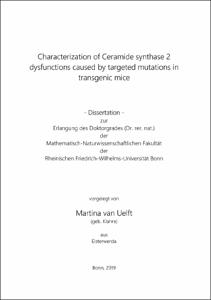Characterization of Ceramide synthase 2 dysfunctions caused by targeted mutations in transgenic mice

Characterization of Ceramide synthase 2 dysfunctions caused by targeted mutations in transgenic mice

| dc.contributor.advisor | Bauer, Reinhard | |
| dc.contributor.author | van Uelft, Martina | |
| dc.date.accessioned | 2020-04-27T15:08:28Z | |
| dc.date.available | 2020-04-27T15:08:28Z | |
| dc.date.issued | 10.02.2020 | |
| dc.identifier.uri | https://hdl.handle.net/20.500.11811/8285 | |
| dc.description.abstract | Ceramide species are the precursor of sphingolipids, which serve as structural components of biological membranes or are bioactive molecules. In mammals, ceramides are synthesised by a family of ceramide synthases (CerS) 1 to 6. They catalyse the N-acylation of a sphingoid long chain base and a fatty acyl-CoA of varying chain length. All ceramide synthases harbour a lag1p motif essentially necessary for catalytic activity and all CerS, except CerS1, contain a homeodomain of unknown function. During this PhD thesis, different CerS2-overexpression constructs were generated and investigated to identify mutations suitable to analyse the catalytic function independent from homeodomain function of the mCerS2 protein. Consequently, two different CerS2 conditional mouse lines were generated, CerS2H212A/H213A (H/A) and CerS2Del79-120 (Del). Both mouse lines show a high mortality rate and develop severe phenotypic alterations. In H/A mice, the coding region of cers2 was exchanged by a CerS2H212A/H213A-eGFP fragment, resulting in the expression of a CerS2 point-mutated protein. Additional IRES-driven GPF-expression was used to monitor cers2H/A expression and to verify the presence of the CerS2H/A protein. In vitro assays confirmed that catalytic activity of CerS2 is lost in H/A mice. Additional qRT-PCR and immunoblot analyses confirmed expression of the CerS2H/A protein in all analysed tissues. Expression levels (mRNA or protein) however do not always correlate with that of WT control. Furthermore, the H/A replacement-mutation results in alterations of lipid and energy metabolism. First, Mass spectrometric analysis showed strong reduction in C22/ C24/ C24:1 ceramide species and an increase in long-chain ceramides (C16/C18), which does not restore the total sphingolipid content. Analysis regarding the storage lipid content of liver highlight significant reduction in TAG, DAG and FFA levels in mutated mice, which is accompanied by reduction in white adipose tissue (WAT) mass. Morphological and histological investigations of H/A mice revealed reduced body weight as well as size, while adipocyte size is even more disproportionately reduced. On standard diet, H/A mice ingest more food, but show less weight gain, which is not based on altered intestinal lipid absorption. Liver sections showed loss of lipid droplet formation and an unexpected loss of glycogen-content. Moreover, catalytic ablation also leads to the development of hepatocellular carcinoma. Transcriptome analyses performed in combination with detailed qRT-PCR analyses show down regulation of genes involved in lipid metabolism. Immunological analyses of H/A mice showed that depletion of catalytic activity and loss of corresponding ceramide species negatively affects egress of mature single positive T cells from the thymus into the periphery. Accumulation of naïve T cells within the thymus results in a mild T cell lymphopenia. The CerS2Del79-120 mutation was verified in cell culture experiments first. After transient transfection of the CerS2Del79-120 plasmid, the mutated CerS2 protein was expressed and further investigations indicate, that the deletion within the homeodomain had no effect on the catalytic activity. Yet, the Del mice show complete loss of the CerS2Del protein, leading to a loss of catalytic activity and a lack of C22-24 ceramide species. Del mice show the same phenotype as the CerS2gt/gt and H/A mice. All findings indicate that the catalytic domain of CerS2 is important for the synthesis of C22/C24 ceramide species. It is also necessary to maintain CerS2s regulatory functions in lipid and energy metabolism and to facilitate those functions, which allow the thymic egress of mature T cells. | en |
| dc.language.iso | eng | |
| dc.rights | In Copyright | |
| dc.rights.uri | http://rightsstatements.org/vocab/InC/1.0/ | |
| dc.subject.ddc | 570 Biowissenschaften, Biologie | |
| dc.subject.ddc | 610 Medizin, Gesundheit | |
| dc.title | Characterization of Ceramide synthase 2 dysfunctions caused by targeted mutations in transgenic mice | |
| dc.type | Dissertation oder Habilitation | |
| dc.publisher.name | Universitäts- und Landesbibliothek Bonn | |
| dc.publisher.location | Bonn | |
| dc.rights.accessRights | openAccess | |
| dc.identifier.urn | https://nbn-resolving.org/urn:nbn:de:hbz:5-57534 | |
| ulbbn.pubtype | Erstveröffentlichung | |
| ulbbn.birthname | Klahre | |
| ulbbnediss.affiliation.name | Rheinische Friedrich-Wilhelms-Universität Bonn | |
| ulbbnediss.affiliation.location | Bonn | |
| ulbbnediss.thesis.level | Dissertation | |
| ulbbnediss.dissID | 5753 | |
| ulbbnediss.date.accepted | 10.01.2020 | |
| ulbbnediss.institute | Mathematisch-Naturwissenschaftliche Fakultät : Fachgruppe Molekulare Biomedizin / Life & Medical Sciences-Institut (LIMES) | |
| ulbbnediss.fakultaet | Mathematisch-Naturwissenschaftliche Fakultät | |
| dc.contributor.coReferee | Witke, Walter |
Dateien zu dieser Ressource
Das Dokument erscheint in:
-
E-Dissertationen (4442)




